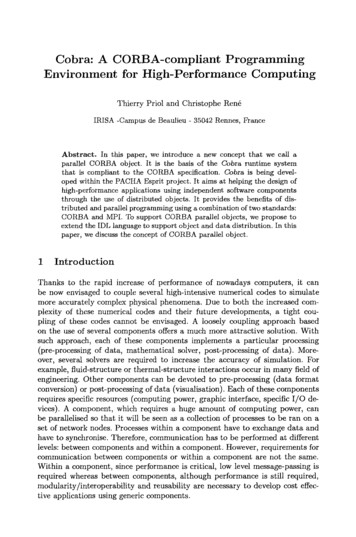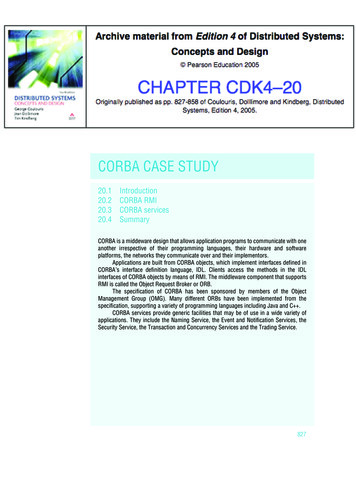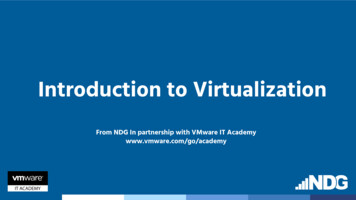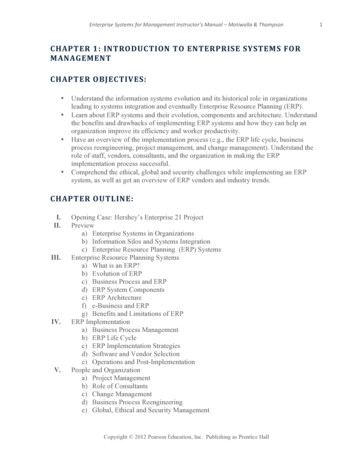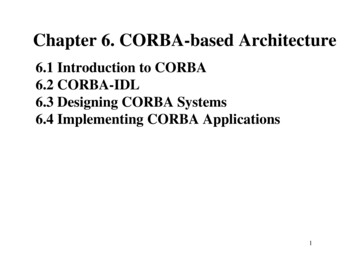
Transcription
Chapter 6. CORBA-based Architecture6.1 Introduction to CORBA6.2 CORBA-IDL6.3 Designing CORBA Systems6.4 Implementing CORBA Applications1
Chapter 6. CORBA-based ArchitecturePart 6.1 Introduction to CORBA1.2.3.4.IntroductionDistributed ArchitectureMiddleware SystemsCORBA Architecture2
1. Introduction CORBA is a software standard that is defined and maintained bythe Object Management Group (OMG). The OMG:-Founded in 1989 by eight companies as a non-profit organization.-The consortium now includes over 800 members.-Charter: establishment of industry guidelines and detailed object managementspecifications to provide a common framework for application development. OMG produces specifications, not implementations-Implementations of OMG specifications can be found on over 50 operating systems CORBA is the acronym for Common Object Request BrokerArchitecture. It consists of a standard framework for developing andmaintaining distributed software systems. Specifically, it provides-A RPC mechanism allowing the invocation of operations across different programming languages,hardware, and operating system platforms, achieving portability and interoperability.3-A component model, the CORBA Component Model (CCM), for reusable component development.
2. Distributed ArchitectureDefinitionA distributed architecture is an architecture supporting the development of applications and servicesthat can exploit a physical architecture consisting of multiple, autonomous processing elements.Those elements do not share primary memory but cooperate by sending messages over the network.Example-Distributed SystemKey Characteristics: Multiple autonomous components Components are not shared by all users Resources may not be accessible Software runs in concurrent processeson different processors Multiple points of control Multiple points of failure4
Underlying Issues-Some of the key challenges involved in designing,implementing and operating a distributed systeminclude: Heterogeneity-Heterogeneous hardware, OS, languages, protocols etc. Concurrency-Resource sharing and concurrent access to data pose the issue of data integrity. Failure-Independent failure: often we want the system to keep working after one or more have failed.-Unreliable communication: connections may be unavailable; messages may be lost. Insecure communication-The interconnections among the computers may be exposed to unauthorized eavesdroppingand message modification. Costly Communication-The interconnections among the computers usually provide lower bandwidth, higherlatency and higher cost communication compared to independent processes in a single5machine
Transparency Distributed systems should be perceived by users and applicationprogrammers as a whole rather than as a heterogeneous collectionof cooperating components: this is referred to as transparency.-Transparency has different dimensions that were identified by ANSAas part of the International Standard of Open Distributed Processing (ODP).-These represent various properties that distributed systems should have.Dimensions of Transparency in Distributed SystemsS c a la b ilit yT ra n s p a re n c yP e rfo rm a n c eT ra n s p a re n c yF a ilu r eT ra n s p a re n c yM ig r a t io nT ra n s p a re n c yR e p lic a t io nT ra n s p a re n c yC o n c u rre n c yT ra n s p a re n c yA ccessT ra n s p a re n c yL o c a tio nT ra n s p a re n c y6
3. Middleware SystemsDefinition: Middleware is software that enables interprocess communication.It provides an API that isolates the application code from the underlying networkcommunication formats and protocols (FAPs).-Middleware systems implement the various forms of distribution transparenciesby creating the illusion of unity and homogeneity within the network, what iscalled in other words the “single-system image”. They act as glue between autonomous components and processes (e.g., clients,server) by providing generic services on top of the OS.C om ponentCom ponentM id d le w a r eC oo me ne t r a t i n g S y s t e mCom ponentN e twr kp oOn pC om ponentH a rd wM ai dr ed l e w a r eCom ponentM id d le w a r eN e tw o r k O p e ra tin g S y s te mH ostH a rd w a reC o m p o n eNn et t w o r k O p e r aCt ionmg p So nyesntte mM i d d l eHwaar rdew a r eN e tw o r k O p e ra tin g S y s te mH ostH a rd w a reH ostN e tw o rkH ost7
-There are three kinds of middleware systems: transaction-orientedmiddleware, message-oriented middleware, and object-orientedmiddleware. Transaction-oriented middleware supports distributed computinginvolving database applications. Message-oriented middleware supports reliable, asynchronouscommunications among distributed components. Object-oriented middleware systems are based on object-orientedparadigm, and primarily supports synchronous communicationsamong distributed components.-The most popular object-oriented middleware paradigms includeCORBA, DCOM, DotNET, and EJB (which is based on RMI). All these middleware systems, also referred to as Object-Oriented middleware,are based on the Remote Procedure Call (RPC) framework foundation. They extend RPC framework by introducing object-oriented mechanisms.8
Example - MiddlewareExample - Distributed Middleware with CORBA9
Remote Procedure Call (RPC)-RPC allows the invocation of operations across different hardwareand operating system platforms. Provide the same mechanism as local procedure call but at the interprocess level. Support a common Interface Definition Language (IDL).-The RPC mechanism is provided by a RPC software, which handlestransparently all the steps involved. The functionality of the RPCsoftware include: Location of the server functions, andand concurrent requests. Parameters passing and datarepresentation. Failure management Security management-The RPC software provides an implementation of the sessionand presentation layer. Note that the transport layer (below) isimplemented as a socket.10
-The presentation layer implementation enables data conversion andformatting (e.g., marshalling/unmarshalling).-The session layer implementation enables clients to locate RPC serversstatically or dynamically, and activates or deactivates RPC serversIDLwhen requests arrive.RPCPresentation layer-Heterogeneous data conversion-Marshalling/unmarshalling (client andserver stubs)With OO middleware such as CORBA:-The presentation layer fulfills the same functionsas corresponding layer for RPC. It is also in chargeof mapping object references to suitable format forthe transport layer.-The session layer is in charge of mapping objectreferences to hosts, activating and deactivatingobjects, executing the requested services,and synchronizing client and server.Session layer-Server location (portmap daemon)-Server activation/deactivation (inetddaemon)Transport layer11
RPC MechanismNetworkDirectoryServiceClientServer2. locate server(Start Up)1. publish(Start Up)3. call function(Client Application)6. Receive RPC(Server runtime)4. pack arguments(Client stub)7. unpack arguments(Server stub)RPC5. Make RPC(Client runtime)8. Execute function(Server application)12
4. CORBA ArchitectureCORBA in a Nutshell In CORBA the services that an object provides are expressed in a contract that serves asthe interface between it and the rest of the system. The Object interface is expressed using a special language named Interface DefinitionLanguage (IDL). For objects to communicate across the network, they need a communication infrastructurenamed Object Request Broker (ORB).ObjectImplementationClientIDLskeletonIDL stubRequestObject Request Broker (ORB) Both client and object implementation are isolated from the ORB by an IDL interface.Clients see only the object’s interface, never the implementation. To communicate, the request does not pass directly from client to object implementation;13instead every request is passed to the client’s local ORB, which manages it.
CORBA Reference Model Architecture-The CORBA standard relies on a reference model named theObject Management Architecture (OMA).A p p lic a tio nO b je c tsC O R B AD o m a in sC O R B AF a c ilitie sO b je c t R e q u e s t B r o k e r (O R B )C O R B AS e r v ic e s- A typical CORBA implementation includes: An Object Request Broker (ORB) implementation An Interface Definition Language (IDL) compiler Implementations of Common Object Services (COS), also calledCORBA Services Common Frameworks, also called CORBA facilities An Internet Inter ORB Protocol (IIOP) implementation14
Interface Definition Language (IDL)-IDL provides a programming language neutral way to define how aservice is implemented. It is an intermediary language between specification languages suchas the UML and programming languages such as C, C etc. It provides an abstract representation of the interfaces that a client will use and a serverwill implement. Clients and object implementation are then isolated by three mechanisms: an IDL stub onthe client end, an ORB, and a corresponding skeleton on the object implementation end.15
Object Request Broker-The interface the client sees is completely independent of where theobject is located, what programming language it is implemented in,or any other aspect that is not reflected in the object’s interface.-The ORB is responsible for: finding the object implementation for the request, preparing the object implementation to receive the request, communicating the data making up the request.16
Structure of Object Request Interfaces17
Object Adapter An object adapter is the primary means for an object implementationto access ORB services such as object reference generation. Object adapters are responsible for the following functions:–Generation and interpretation of object references–Method invocation–Security of interactions–Object and implementation activation and deactivation–Mapping object references to the corresponding object implementations–Registration of implementations18
Common Object Services (COS)-Up to 15 services are currently available that assist the ORB. They are defined on top of the ORB, as standard CORBA objects withIDL lar services include: Naming Service: provides a way for CORBA clients (and servers) tofind objects on the network. Event Service: stores and delivers events sent by clients or servers totheir target objects. Security Service: provides a means to authenticate messages, authorizeaccess to objects, and provide secure communications. Transaction Service: defines a means to control an action against adatabase or other subsystem.19
ORB Interoperability Architecture-One of the goals of the CORBA specification is that client andobject implementations are portable.-Interoperability is more important in a distributed system thanportability.-CORBA 2.0 added interoperability as a goal in the specification,under the form of interoperability protocols: Inter-ORB Bridge Support General Inter-ORB Protocol (GIOP) Internet Inter-ORB Protocol (IIOP) Environment-Specific Inter-ORB Protocols (ESIOPs)20
Inter-ORB Bridge Support-The role of a bridge is to ensure that content and semantics are mapped from theform appropriate to one ORB to that of another, so that users of any given ORBonly see their appropriate content and semantics.-The General Inter-ORB Protocol (GIOP) specifies a standard transfer syntax(low-level data representation) and a set of message formats for communicationsbetween ORBs. The protocol is specifically built for ORB to ORB interactions and is designed to work directlyover any connection-oriented transport protocol that meets a minimal set of assumptions.-IIOP (Internet Inter-ORB Protocol) is a TCP/IP implementation of GIOP. IIOP is used in other systems that do not even attempt to provide the CORBA API(e.g, “RMI over IIOP”, EJB etc.) Because they all use IIOP, programs written to these APIs caninteroperate with each other and with CORBA programs.21
Examples of CORBA ProductsORBDescriptionOrbacusA popular Java and C ORBfrom Iona TechnologiesWebSphereA popular application server withan ORB from IBMNetscape CommunicatorNetscape browsers have a versionof VisiBroker embedded in themSun Java 2 PlatformProvides an ORB and twoCORBA programming models:-RMI programming model-IDL programming modelExamples ORBs implementations Client- and Implementation-resident ORB Server-based ORB System-based ORB Library-based ORB22
Interface Definition Language (IDL)-IDL provides a programming language neutral way to define how a service is implemented. It is an intermediary language between specification languages such as the UML and programming languages such as C, C etc. It provides an abstract representat
